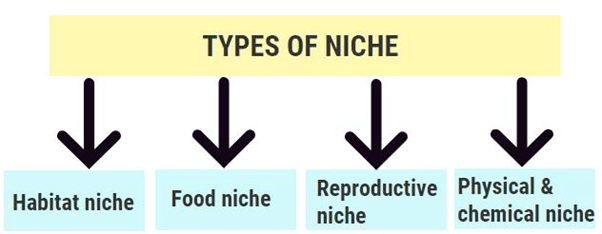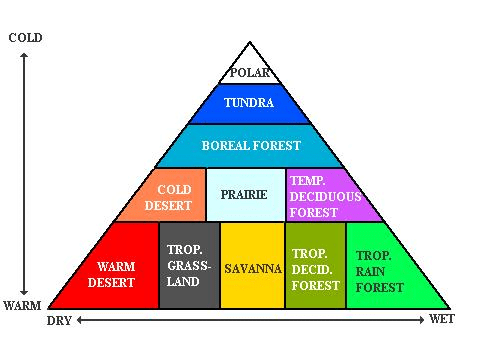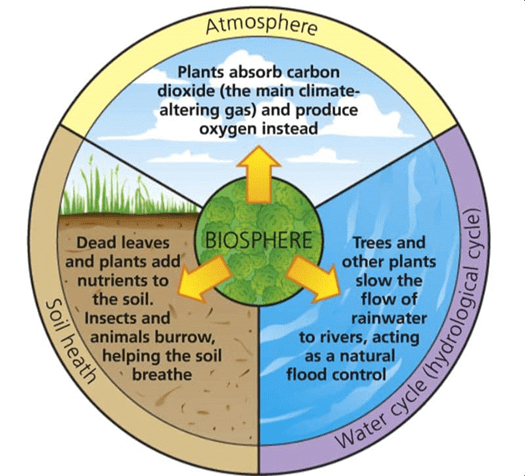UPSC Exam > UPSC Notes > Environment for UPSC CSE > Ecology - 2
Ecology - 2 | Environment for UPSC CSE PDF Download
| Table of contents |

|
| What Is Ecotone? |

|
| What is Ecological Niche? |

|
| BIOME |

|
| Aquatic Zones |

|
| What is Biosphere? |

|
What Is Ecotone?
The junction between two or more diverse ecosystems is known as Ecotone.
Example: The mangrove forests represent an ecotone between marine and terrestrial ecosystems. Other examples: Grassland, Estuary and Riverbank

What are its Characteristics?
- It may be very narrow or quite wide.
- It has the conditions intermediate to the adjacent ecosystems. Hence, it is a zone of tension.
- It is linear as it shows a progressive increase in species composition of one incoming community and a simultaneous decrease in species of the other outgoing adjoining community.
- Well-developed ecotones contain some organisms which are entirely different from that of the adjoining communities.
- Sometimes the number of species and the population density of some species is much greater in this zone than either community. This is called edge effect.
The organisms which occur primarily or most abundantly in this zone are known as edge species. In the terrestrial ecosystems edge effect is especially applicable to birds.
For example, birds' density is greater in the mixed habitat of the ecotone between the forest and the desert.
What is Ecological Niche?
- A niche is the unique functional role or place of a species in an ecosystem. It is a description of all the biological, physical and chemical factors that a species needs to survive, stay healthy and reproduce.
- A niche is unique for a species, which means no two species have identical niches. Niche plays an important role in the conservation of organisms. If we have to conserve species in its native habitat, we should know the niche requirements of the species and ensure that all requirements of its niche are fulfilled.
Types of Niche

- Habitat niche – Where it lives
- Food niche – What it eats or decomposes & what species it competes with
- Reproductive niche – How and when it reproduces.
- Physical & chemical niche – Temperature, Land shape, Land slope, Humidity & another requirement.
BIOME
 What is it?
What is it?
- The terrestrial part of the biosphere is divisible into enormous regions called biomes characterized by climate, vegetation, animal life and general soil type.
- Biome distribution based on temperature and precipitation
- No two biomes are alike. The climate determines the boundaries of a biome and abundance of plants and animals found in each one of them. The most important climatic factors are temperature and precipitation.
Aquatic Zones
- Aquatic systems are not called biomes. However, they are divided into distinct life zones, with relatively distinct plant and animal life regions.
- The major differences between the various aquatic zones are salinity, dissolved nutrients, water temperature, and depth of sunlight penetration.
What is Biosphere?
- The biosphere is a part of the earth where life can exist. Biosphere represents a highly integrated and interacting zone comprising the atmosphere (air), hydrosphere (water) and lithosphere (land).

- It is a narrow layer around the surface of the earth. If we visualize the earth as the size of an apple, the biosphere would be as thick as its skin. Life in the biosphere is abundant between 200 metres (660 feet) below the ocean's surface and about 6,000 metres (20,000 feet) above sea level.
- The biosphere is absent at extremes of the North and South poles, the highest mountains and the deepest oceans since existing hostile conditions do not support life. Occasionally, fungi and bacteria do occur at a great height beyond 8,000 metres, but they are not metabolically active and represent only dormant life. The energy required for life within the biosphere comes from the sun.
- The nutrients necessary for living organisms come from air, water and soil. The same chemicals are recycled over and over again for life to continue. Living organisms are not uniformly distributed throughout the biosphere. Only a few organisms live in the polar regions, while the tropical rain forests have an exceedingly rich diversity of plants and animals (50% of Global Biodiversity).
Question for Ecology - 2Try yourself:Which of the following is not an Ecotone?
View Solution
The document Ecology - 2 | Environment for UPSC CSE is a part of the UPSC Course Environment for UPSC CSE.
All you need of UPSC at this link: UPSC
|
95 videos|230 docs|52 tests
|
FAQs on Ecology - 2 - Environment for UPSC CSE
| 1. What is an ecotone? |  |
Ans. An ecotone is a transition area between two different ecosystems, where two communities meet and integrate. It may have a unique mix of species and characteristics not found in either of the adjacent ecosystems.
| 2. What is an ecological niche? |  |
Ans. An ecological niche refers to the role and position of a species within an ecosystem. It includes how a species obtains and uses resources, interacts with other species, and functions within its environment.
| 3. What is a biome? |  |
Ans. A biome is a large geographical area of distinctive plant and animal groups that are adapted to that particular environment. Biomes are determined by factors such as climate, geography, and vegetation.
| 4. What are aquatic zones? |  |
Ans. Aquatic zones are regions in bodies of water with distinct characteristics based on factors such as depth, temperature, and light availability. Examples include the littoral zone, limnetic zone, and profundal zone in lakes.
| 5. What is the biosphere? |  |
Ans. The biosphere is the global ecological system that integrates all living organisms and their interactions with the physical environment. It includes all ecosystems on Earth and supports life as we know it.
Related Searches





















